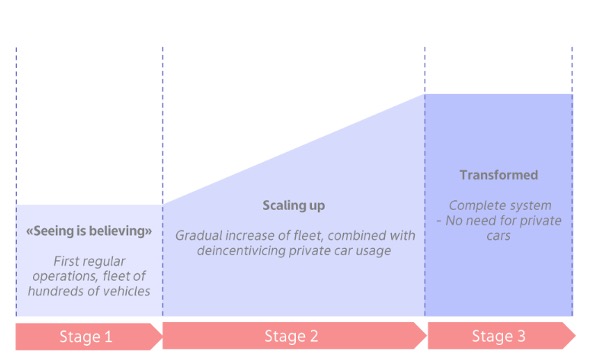Sustainable Freedom of Movement: The Opportunity and the Challenge
By Endre Angelvik, Ruter

The heart of sustainable mobility: Ridesharing (Photo: Ruter)
Europe was the fastest-warming continent on the planet in 2023 and is grappling with transportation's outsized role in environmental degradation. In Norway, transport is the largest contributor to CO2 emissions, accounting for 61% of total emissions and underscoring the need for significant systemic shifts. In Ruter, our vision aligns with the growing global consensus: to reduce vehicle kilometers traveled and replace private car journeys with more efficient and sustainable alternatives.
The Oslo study serves as a key reference point for us, demonstrating the tangible benefits of shared mobility solutions, how they can reduce vehicle kilometers driven by up to 30%, reduce the needed vehicle fleet with over 90%, as well as reduced waiting and detour times in on-demand, ridesharing scenarios. These results highlight that reducing private car dependency is not only feasible but also desirable for improving commuter experiences and achieving sustainability goals.
The Vision for Shared Autonomous Mobility
Our exploration of Shared Autonomous Vehicle (SAV) systems reveals a meticulously thought-out framework aimed at maximizing societal and environmental benefits. Key design principles include:
- Ridesharing as a Core Principle:
By prioritizing ridesharing, SAV systems can drastically cut kilometers traveled per vehicle, thus reducing emissions and congestion.
- Integrated Fleet Operations:
A integrated fleet approach prevents redundancy and inefficiencies that arise from competing systems, ensuring smoother operations and maximized benefits.
- Seamless Public Transit Integration:
SAV systems are designed to complement and work together with public transportation networks, amplifying their utility while mitigating private car use.
- Scalability:
Large-scale implementation is essential for reliability, sustainability, and economic viability, enabling SAVs to compete with private cars effectively.
- Replacing Private Car Journeys:
The system's success hinges on transitioning private car users to SAVs, thereby reducing carbon footprints while maintaining accessibility.
Lessons from Pilot Projects
Since 2018, we have carried out 5 pilot initiatives showcasing the potential of autonomous vehicles under varied conditions. These trials underscore the feasibility of autonomous mobility, providing results such as thousands of kilometers driven in autonomous mode, and thousands of passengers served during the projects. They offer critical insights into operational challenges and highlight the importance of technology integration.
A Phased Approach to Transformation
We envision a three-stage roadmap for transitioning to sustainable mobility systems:
- Foundation Building:
This stage focuses on piloting and testing SAV systems in controlled environments to identify operational best practices.
- Scaling Up:
The emphasis shifts to integrating these solutions into existing public transit systems on a larger scale.
- Comprehensive Transformation:
The final stage involves widespread adoption, replacing private vehicles and transforming urban mobility dynamics altogether.

Customer-Centric Mobility
At the heart of this strategy is the customer. Shared, on-demand services are designed to offer unparalleled convenience, reducing wait and travel times while ensuring affordability and accessibility.
The Road Ahead
Despite these promising advances, the future is still in the making. Success requires continuous innovation, robust public-private partnerships, and unwavering commitment to sustainability goals. By aligning technological advancements with user-centric design and environmental priorities, we can create a more sustainable future together. And we need to put sharing at the heart of that future!